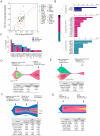Landscape of biallelic DNMT3A mutant myeloid neoplasms
- PMID: 39334207
- PMCID: PMC11438130
- DOI: 10.1186/s13045-024-01607-9
Landscape of biallelic DNMT3A mutant myeloid neoplasms
Abstract
DNA methyltransferase 3 A mutations (DNMT3AMT) are frequent in myeloid neoplasia (MN) and mostly heterozygous. However, cases with multiple DNMT3AMT can be also encountered but their clinical and genetic landscape remains unexplored. We retrospectively analyzed 533 cases with DNMT3AMT identified out of 5,603 consecutive MNs, of whom 8.4% had multiple DNMT3AMT hits. They were most frequent in acute myeloid leukemia (AML) with R882 variant accounting for 13.3% of the multi-hits. Multiple DNMT3AMT more likely coincided with IDH2 (P = 0.005) and ETV6 (P = 0.044) mutations compared to patients with single DNMT3AMT. When the sum of variant allele frequencies (VAFs) for multiple DNMT3AMT exceeded 60%, we found a significant positive clonal burden correlation of the two DNMT3A variants (P < 0.0001) suggesting that they occurred in biallelic configuration. AML patients with biallelic DNMT3A inactivation (n = 52) presented with older age (P = 0.029), higher leukocytes (P < 0.0001) and peripheral blast counts (P = 0.0001) and significantly poorer survival rate (5.6% vs. 47.6% at 2 years; P = 0.002) than monoallelic DNMT3AMT. Multivariate analysis identified biallelic DNMT3AMT (HR 2.65; P = 0.001), male gender (HR 2.05; P = 0.014) and adverse genetic alteration according to the European LeukemiaNet 2022 classification (HR 1.84; P = 0.028) as independent adverse factors for survival, whereas intensive chemotherapy (HR 0.47; P = 0.011) favorably influenced outcomes. Longitudinal molecular analysis of 12 cases with biallelic DNMT3AMT demonstrated that such clones persisted or expanded in 9 relapsed or transformed cases (75%) suggesting the early origin of biallelic hits with strong leukemogenic potential. Our study describes the likelihood that biallelic DNMT3AMT, while rare, are indeed compatible with clonal expansion and thus questions the applicability of synthetic lethality strategies.
Keywords: DNMT3A mutation; Acute myeloid leukemia; Myelodysplastic syndrome; Myeloproliferative neoplasms.
© 2024. The Author(s).
Conflict of interest statement
The authors declare no competing interests.
Figures


References
-
- Gaidzik VI, Schlenk RF, Paschka P, Stölzle A, Späth D, Kuendgen A, et al. Clinical impact of DNMT3A mutations in younger adult patients with acute myeloid leukemia: results of the AML Study Group (AMLSG). Blood. 2013;121(23):4769–77. - PubMed
Publication types
MeSH terms
Substances
Grants and funding
LinkOut - more resources
Full Text Sources
Medical
Research Materials
Miscellaneous

